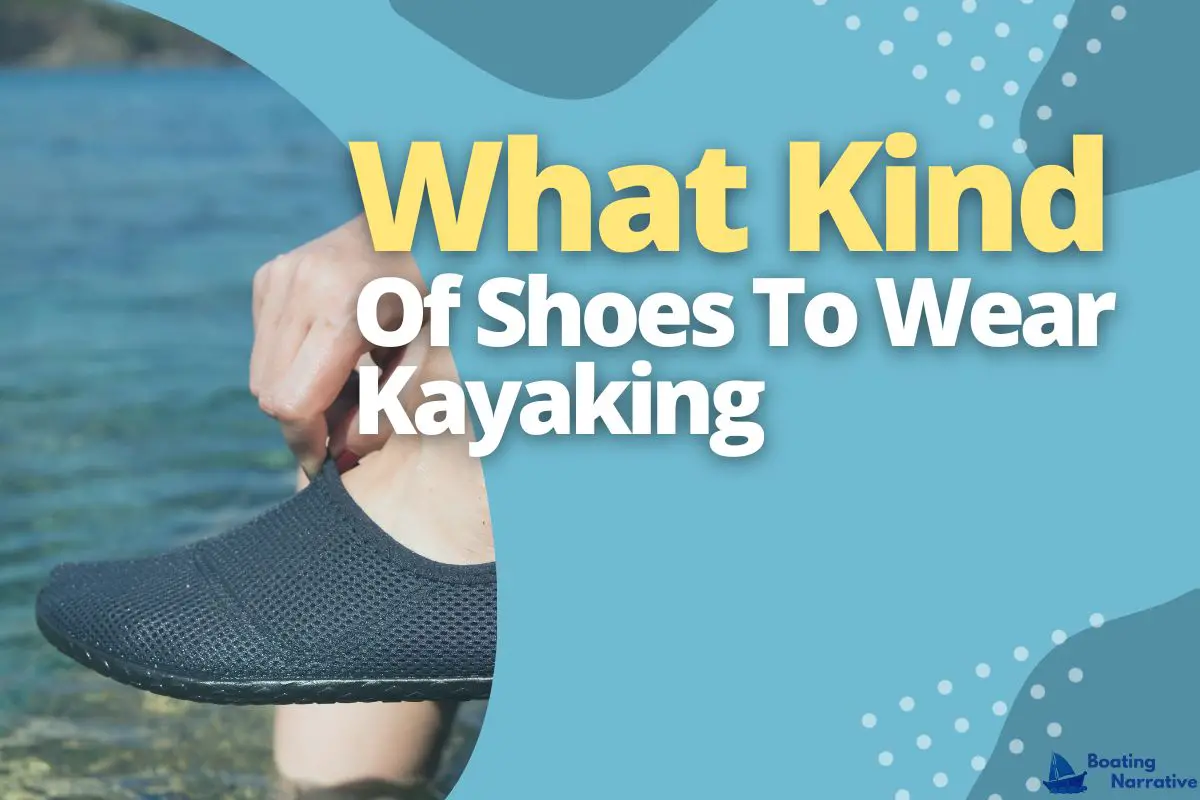You want to ensure you’re comfortable and safe while kayaking on the water. That means having the right gear, including the right shoes. But what kind of shoes should you wear kayaking?
In this blog post, I’ll also give tips on what to look for when choosing kayaking shoes and what to avoid. So read everything you need to know about choosing the right footwear for your next kayaking adventure.
Key Takeaways
- Wear shoes that will protect your feet from rocks and debris in the water
- Shoes should have a good grip to prevent slipping on wet surfaces
- Water shoes or sandals are ideal for kayaking
- Avoid wearing shoes with open or porous toes or heels
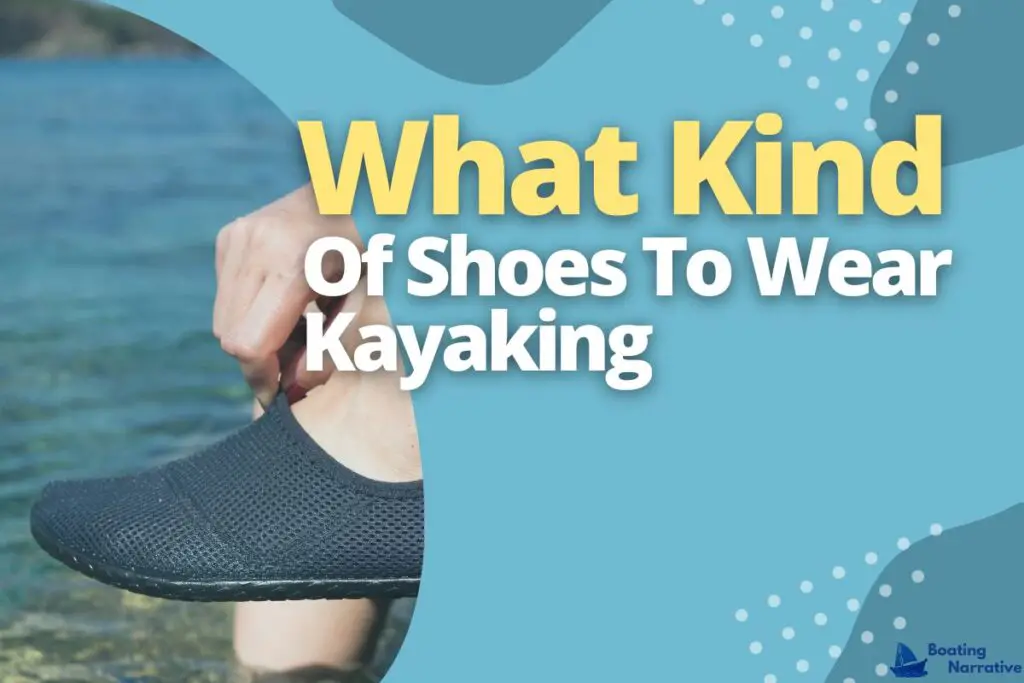
Here’s The Answer To What Kind Of Shoes To Wear Kayaking
When deciding what kind of shoes to wear kayaking, there are many factors, such as the weather, the type of water you’ll be paddling in, and your preferences.
In general, you’ll want a shoe that is lightweight and quick-drying with a good grip. If you’re kayaking in warm weather, a pair of sandals or water shoes with drainage holes is a great option.
Crocs are also popular among kayakers because they are comfortable and lightweight. However, if you’ll be paddling in cold weather or moving water, you’ll want a shoe with more coverage.
A neoprene water shoe is a good option for cold weather because it will keep your feet warm. For moving water, look for a shoe with a strap or velcro closure to prevent your feet from slipping.
No matter what kind of kayaking trip you take, having a good pair of shoes is crucial. They can significantly impact your safety and comfort while boating.
Wear Shoes That Will Protect Your Feet From Being Scraped By Rocks
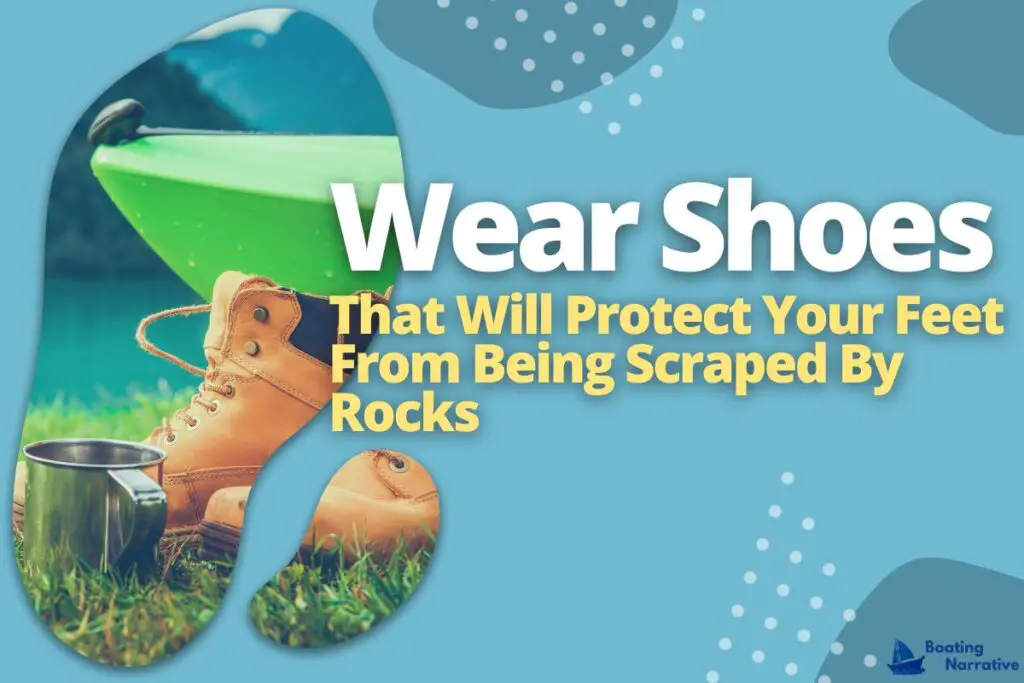
You should wear shoes that are closed-toed and closed-heeled. This will help to protect your feet against being scraped by rocks and shells or cut by finned fish.
You should also ensure that your shoes have a good grip to keep your footing on slippery surfaces such as wet rocks.
Your shoes should be comfortable and waterproof, so they don’t become saturated with water after swimming in cold waters.
Shoes Should Also Have Good Traction To Prevent Slipping On Wet Surfaces
You want to make sure your shoes have good traction for several reasons. It’s essential for safety. If you’re in an area with slippery rocks or wet surfaces and you’re not wearing shoes that have great traction, then you run the risk of slipping and falling into the water.
This could cause injury to yourself and others around you, so it’s better to be safe than sorry when finding shoes that work well on wet surfaces.
And most importantly: having good traction reduces fatigue. When out on the river, every ounce counts when trying to stay afloat longer or paddling through choppy waters—and having footwear with excellent grip helps ensure this happens more efficiently.
Canvas Shoes Or Old Sneakers Are Often Avoided For Kayaking
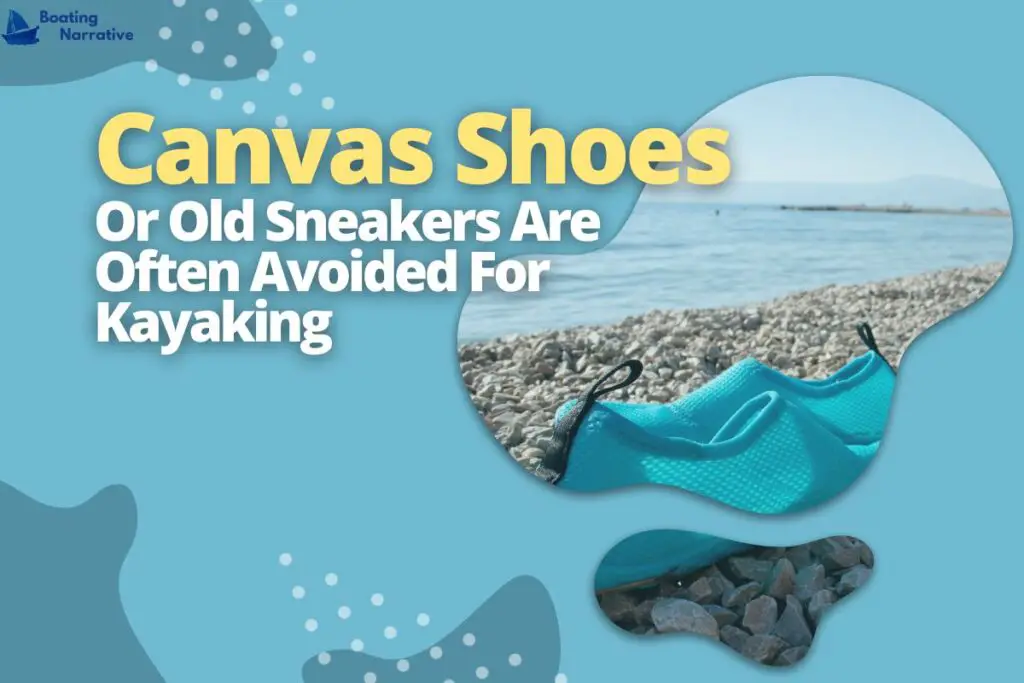
It’s important to know that while canvas shoes or old sneakers may be your go-to shoe for everyday use, they are often avoided on the water. Canvas shoes are not waterproof and will soak through in the water when you step foot in them.
This can make kayaking uncomfortable for those wearing them and cause a wet spot on your deck that could get slippery if it gets any bigger than it already is from being soaked up by the material.
No one wants their feet to get soggy during a workout session. In addition, canvas shoes are not very durable. Usually, they don’t last very long before they start ripping apart at the seams or showing signs of wear from constant use over time (and even then, there is no guarantee that they won’t fall apart on you).
Instead, opt for anything composed of nylon if you want something durable – nylons tend to be much stronger than their cotton counterparts, so they’ll last longer without needing repairs.
Some Kayakers Prefer Neoprene Booties
Sometimes, kayakers prefer to wear neoprene booties instead of traditional shoes. Both socks and no socks can be worn with them.
Neoprene is a good material for kayakers because it keeps your feet warm and dry.
It’s also useful in the winter—when you may have to paddle in cold water—and in the summertime when getting wet from splashing on shore is a possibility.
Sturdy Sandals Or Water Shoes Are Also An Option For Kayaking
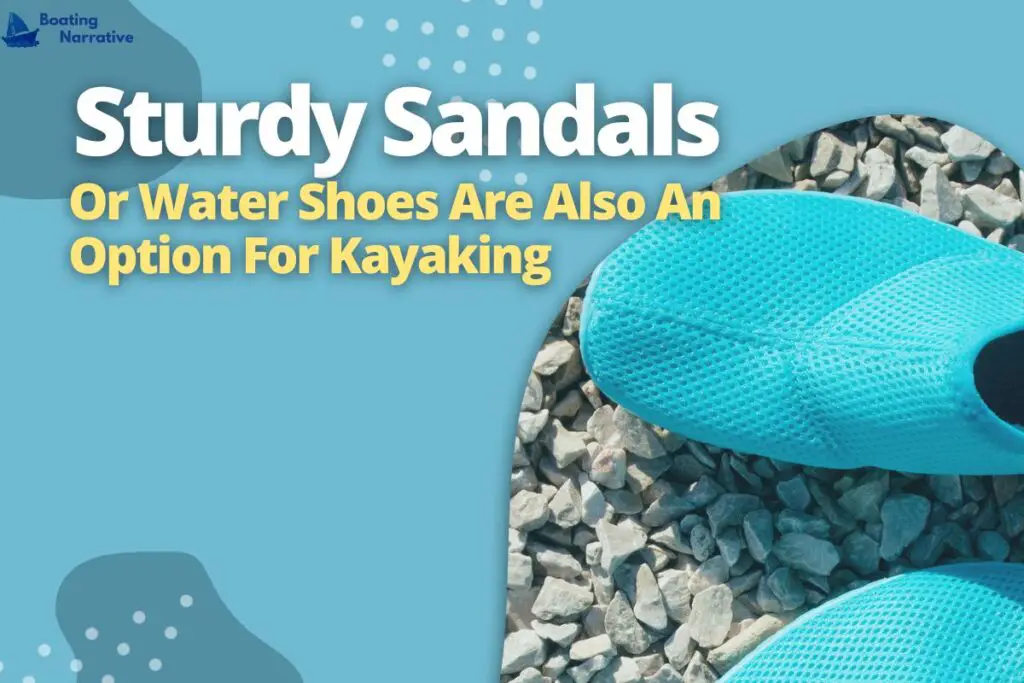
If you want to avoid the hassle of changing into dry shoes and socks at the end of your trip, sturdy sandals or water shoes are the way to go.
- They’re made to hold up in all conditions and can be worn on land or water without compromising comfort or safety.
- When looking for a pair of sandals or water shoes, ensure they are waterproof and have a good grip on wet surfaces—you don’t want your boat drifting away while you struggle with slippery soles.
Comfort is also key; if it doesn’t feel good when walking barefoot on slippery rocks, it won’t feel any better once you’ve been out in the sun all day.
The Different Types Of Kayaking Shoes
To get an idea of the various options, there are three main types of kayaking shoes: water shoes, canvas shoes, and neoprene booties. If kayaking is new to you, you could be confused by the differences between these choices.
Water Shoes: The best thing about this category is that they are affordable. You can usually buy a decent pair for under $100. The downside is that they can be slippery when wet and don’t have much support regarding comfort levels while paddling or hiking along rocky terrain.
Neoprene shoes: Neoprene shoes are versatile water sport shoe that can be used for many different activities. They have a sturdy rubber sole that can grasp jagged rocks. They also have a polyester upper that is breathable and quick drying. Neoprene shoes are the best kayaking shoes because they are comfortable, durable, and provide good footing.
How To Choose The Right Kayak Shoe For You?
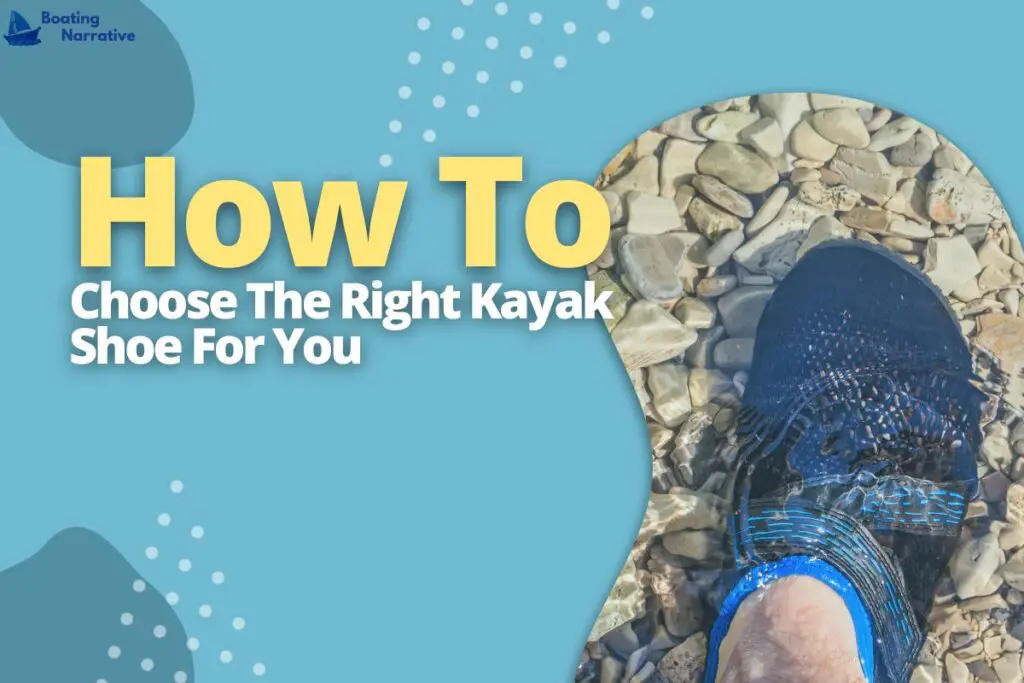
The best kayak shoes are the ones that are comfortable, durable, and waterproof. Additionally, you want to select footwear that supports your feet and has high traction. A proper fit is also important when choosing the right shoes for kayaking.
You last want to be uncomfortable in your shoes while paddling on the water or at camp. If you do not have proper ankle support, there is a chance that you could get injured.
I have tried a variety of shoes and have been paddling for years. I have found that neoprene shoes are the best for kayaking. They are comfortable, durable, and provide good footing. I also like that they dry quickly and are breathable.
If you are looking for the best kayaking shoes, I highly recommend neoprene shoes. They will give you the comfort, durability, and good footing needed to enjoy your time on the water.
What To Look For When Buying Kayak Shoes?
Three aspects should be taken into account while purchasing kayak shoes:
- Fit. Your toes need to be able to play out and grip the deck of your kayak.
- Traction. If a shoe doesn’t have good traction, it can be hard for you to keep yourself from slipping overboard when maneuvering in rough waters or on rocky terrain.
- Protection. Anyone who has ever been on a kayaking trip knows how dangerous it is to sustain a foot injury. Kayak shoes are designed with this in mind—most are made from synthetic materials that protect against sharp objects like rocks, debris floating around in water bodies, and even other boaters’ paddles if they happen to collide with yours on accident (which happens more often than one might think).
The Importance Of A Good Kayak Shoe
In case you’re not aware, the main purpose of kayak shoes is to protect your feet from rocks, shells, and fish fins. They should also have good traction to prevent slipping on wet surfaces.
- The material of the kayak shoe is important because it will determine how comfortable the shoe is and how long it will last. There are three main materials that kayak shoes are made from neoprene, synthetic, and leather.
- Breathability is important in a kayaking shoe because you will paddle in the water, and your feet will get wet. The last thing you want is for your shoes to get sweaty and uncomfortable on your feet.
- The outsole of a kayaking shoe is also important because it needs good traction so you don’t slip on wet surfaces. A good outsole will also provide protection from rocks and other sharp objects that you may come into contact with while paddling.
What Kind Of Socks To Wear With Kayaking Shoes?
This section will tell you what kind of socks to wear with kayaking shoes. There are two main types of socks: neoprene and synthetic. Neoprene is more comfortable, but synthetic is tougher and can keep your feet dry in wet conditions.
What kind of sock thickness do I need? The right choice depends on what you’ll be doing while wearing your kayaking shoes.
Thinner socks are fine if it’s just a short trip down the river because they’re lighter weight, more comfortable, and less expensive than thicker ones.
But if you’re going on longer treks through rough terrain where comfort might be an issue (like hiking trails), then thicker ones might be better suited to protect against blisters from rubbing against hard surfaces like rocks or tree roots.
Conclusion
There are a few things to consider when choosing the right shoes for kayaking. Firstly, you need to consider what kind of kayaking you will do.
Whitewater kayaking will require different footwear than flatwater kayaking. You must also consider the weather and water conditions and your personal preferences.
The most important thing is to ensure that your feet are comfortable and protected on the water. Various shoes are available specifically for kayaking, so do some research and find the best option.
If you’re looking for more information on what kind of shoes to wear kayaking, check out our other articles on the topic. And be sure to stay up-to-date with all our latest updates by following us on our website and social media channels.

